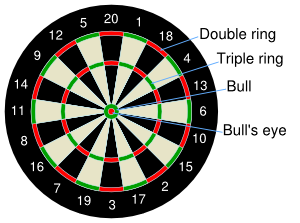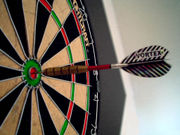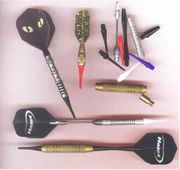 Standardized dart board.
Standardized dart board.
Darts is a game, or rather a variety of related games, in which darts are thrown at a circular target (dart board) hung on a wall. Though various different boards and games have been used in the past, the term 'darts' usually now refers to a standardized game involving a specific board design and set of rules.
As well as being a professional competitive sport, darts is a traditional pub game, commonly played in the United Kingdom (the first to officially recognize darts as a sport), the Netherlands, Israel, the Scandinavian countries, the United States and elsewhere.
Contents |
Dart boards
Dart boards are usually made of sisal fibers and each section is lined with thin metal wire. The numbers indicating the various scoring sections of the board are normally made of wire, especially on tournament-quality boards, but may be printed directly on the board instead.
Height and distance
In the standard game, the dart board is hung so that the bullseye is 5 ft 8 in (1.73 m) from the floor, eye-level for a six foot man. The oche (pronounced 'ock-ey'), or throwing line behind which the player must stand, is 7 ft 9.25 in (2.37 m) from the face of the board, though a few British pubs set it at 8 ft (2.44 m) or 8 ft 6 in (2.59 m). For casual play, it is not uncommon to find the oche somewhat further or closer than the tournament standard, either due to rounding of the specified distance (to 7.5 or 8 feet), or just due to measurement error (such as measuring from the wall, rather than using a plumb line to measure from the board face).
History
Various designs of dartboard have been used, and regional variations remain in parts of Staffordshire, Lancashire and Yorkshire. In particular, the Yorkshire board differs from the standard board in that it has no treble ring and has a single, inner bull. The dartboard itself may have its origins in the cross section of a tree, although some historical records suggest that the first standard dartboards were the bottoms of wine casks, hence the game's original name of "butts". There is speculation that the game originated among soldiers throwing short arrows at the bottom of the cast or at the bottom of trunks of trees. As the wood dried, cracks would develop, creating "sections". Soon, regional standards emerged and many woodworkers supplemented bar tabs by fabricating dart boards for the local pubs.
The numbering plan known by many today has a 20 on top; however, a great many other configurations have been used throughout the years and in different geographical locations. By most accounts, the numbering layout was devised by Brian Gamlin in 1896 to penalize inaccuracy. Although this applies to most of the board, the left-hand side (near the 14 section) is preferred by beginners, for its concentration of larger numbers. Mathematically, removing the rotational symmetry by placing the "20" at the top, there are 19!, or 121,645,100,408,832,000 possible dartboards. There are many different layouts that would penalize a player more than the current setup; however, the current setup actually does the job rather efficiently [1].
Scoring
 A double bullseye.
A double bullseye.
The standard dartboard is divided into twenty numbered sections, scoring from one to 20 points, by wires running from the small central circle to the outer circular wire. Circular wires within the outer wire divide each section into single, double and triple areas.
Various quite different games can be played (and still are played informally) using the standard dartboard. However, in the official game, any dart landing inside the outer wire scores as follows:
- Hitting one of the large portions of each of the
numbered sections, traditionally coloured black and
yellow, scores precisely the points value of that
section.
- Hitting the thin outer portions of these sections, coloured red and green, scores double the points value of that section.
- Hitting the thin inner portions of these sections, roughly halfway between the outer wire and the central circle and again coloured red or green, scores triple (or 3x) the points value of that section.
- The central circle is divided into a green outer ring worth 25 points (known as "outer" or "outer bull") and a red inner circle (usually known as "bull", "inner bull" or "double bull"), worth 50 points. The term "bullseye" can mean either the whole central part of the board or just the inner red section.
- Hitting outside the outer wire scores nothing.
- Any dart that does not remain in the board after throwing (for example, a dart that hits a wire and bounces out of the board or drops out with the impact of a later throw) also scores nothing. Variations on this rule exist - some judge that a dart which obviously hits a scoring section but then subsequently drops out will count if caught before it hits the floor or if it rebounds behind the throwing line before touching the ground it may be thrown again. In professional rules, a dart's tip must be touching a scoring section for the dart to count.
The highest score possible with 3 darts is 180, obtained when all three darts land in the triple 20. In the televised game, the commentator frequently announces a score of 180 in exuberant style.
Soft tip boards and darts
 A selection of soft tip darts and components;
included are brass, nickel/silver and
nickel/tungsten bodies, various tips, and
different shafts and flights.
A selection of soft tip darts and components;
included are brass, nickel/silver and
nickel/tungsten bodies, various tips, and
different shafts and flights.
A relatively new type of board is the soft tip board, which is made of plastic and cast with small holes (about .08 inches, or 2 mm) in the face. The soft tip darts are, in general, lighter than the steel tipped darts, and have a lower maximum allowable weight. The soft tip darts have semi-rigid tapered plastic tips that will penetrate the holes cast in the board to a depth of about .25 inches (6 mm) before lodging securely in place. The darts may be removed from the board by a gentle twist and pull. While still dangerous, soft tip darts are less likely to cause serious injury if they hit a person, and are far less likely to damage items they hit if they bounce out of the board. Since the plastic tips are prone to chip, bend and break with use, even inexpensive soft tip darts are made with replaceable tips, and replacement tips are sold in quantity.
Other than the difference in maximum allowable weights of darts, soft tip dart rules are the same as those for steel tip darts. One big advantage of the soft tip dart for the recreational player is the availability of electronic boards that will detect and score each dart hit, and track the score of each player. Many of these electronic dart boards have dozens of different dart games and variations programmed in, and will even coach a player as to where to aim his next throw.
Playing darts
A game, or "leg", of darts is usually contested between two players who take turns in throwing up to three darts. Starting from a set score, usually 501 or 301, a player wins by reducing his score to zero. The last dart in the leg must hit either a double or the inner portion of the bullseye, which is the double of the outer bull, and must reduce the score to exactly zero. Successfully doing so is known as "doubling out" or "checking out". A throw that would reduce a player's score to one or below zero does not count, his turn ends, and his score is reset to what it was before that turn. (Sometimes in friendly games a player is allowed a dog's chance by "splitting the eleven" if he has a remaining score of 1. This required placing a final dart between the legs of the number eleven in the normally non-scoring part of the board). Since the double areas are small, doubling out is usually the most difficult and tense part of a leg. Longer matches are often divided into sets, each comprising some number of legs.
Although playing straight down from 501 is standard in darts, other variations exist, notably "doubling in", where players must hit a double to begin scoring, with all darts thrown before said double contributing nothing to his score. Other games that are commonly played differ in their scoring methods. These include "Round The Clock", "Killer" and the more complicated Cricket.
In Round the Clock, players must hit each numbered section in turn, finishing with a bull to win. Far from being a beginner's game, Round The Clock is a good training games since it practices targeting all areas of the board, a skill which is essential when finishing a classic leg. This can be taken further by only counting the double or the treble rings.
An additional rule which can add some spice to playing Round The Clock with two or more players is that any dart that falls in a bed other than the one aimed for is forteited to any player(s) awaiting that number.
In Killer, a number of players "own" a number on the dartboard (often selected by throwing a dart with their non-playing arm) and compete to build up "lives" (by hitting that number) until a threshold is reached (usually 4 or 6) before attempting to "kill" other players by removing the lives they have built up (by hitting those other players' numbers) until a single player is left.
Professional organizations
Of the two professional organisations, the British Darts Organisation (BDO), founded 1973, is the older. Its tournaments are often shown on the BBC in the UK, and on SBS6 in the Netherlands. The BDO is a member of the World Darts Federation (WDF) (founded 1976), along with organisations in some 60 other countries worldwide. The BDO organises all British darts players, with the exception of a small group of professionals.
In 1994 a breakaway organisation was formed, initially known as the World Darts Council (WDC) but shortly after known as the Professional Darts Corporation (PDC). Over the years a continued exodus of top players from the BDO has established the PDC as the home of Professional Darts. An influx of sponsors and rapid expansion of television coverage continues. Tournaments are broadcast in the UK on Sky Television, - in the Netherlands by Sport One with many other tv stations now involved across the globe.
The PDC tournaments often have higher prize money and without doubt the best player in the world - 13 times World Champion Phil Taylor. Cementing the PDC's dominance at the very top of the game in early 2006, four times BDO world champion Raymond van Barneveld moved to the PDC.
Professional competitions
The major tournament within both the PDC and BDO organisations are the World Championships which take place at the start of each year. The BDO tournament has been running since 1978, the PDC tournament since 1994 and in 2006 the first prize offered and total prize fund of the PDC World Championship was double that offered by the BDO tournament. (£100,000 to the PDC Champion, £50,000 to the BDO Champion).
The other main professional tournaments are ; Darts Premier League, UK Open, Las Vegas Desert Classic, World Matchplay, World Grand Prix (PDC - all televised live and in their entirety)
International Darts League, World Darts Trophy, World Masters (BDO/WDF - with the former two only broadcast on Dutch tv (SBS6), and the latter broadcast on SBS6 and by the BBC in the UK)
The WDF World Cup (for national teams) has been played bi-annually since 1977.
The Professional Darts Corporation has lauch the World Series of Darts for the first time in the United States. The World Series of Darts, and its $1 million prize will showcase Pro Darts in the United States. The event will be held at the Moheagen Sun casino in Connecticut May 19-21, 2006 and will be subsequently televised on ESPN this summer.
Amateur competition
- The American Darters Association offers league organization for casual singles players throughout the United States (http://www.adadarters.com/)
- The American Darts Organization is the world's largest national dart league, facilitating the organization of members' regional divisions, and promoting the sport via pub-based teams and individuals across the country (http://www.adodarts.com/)
Betting
On premises where alcohol is consumed, English law has long permitted betting only on games of skill, as opposed to games of chance, and then only for small stakes. An apocryphal tale relates that in 1908, Jim Garside, the landlord of the Adelphi Inn, Leeds, England was called before the local magistrates to answer the charge that he had allowed betting on a game of chance, darts, on his premises. Garside asked for the assistance of local champion William "Bigfoot" Anakin who attended as a witness and demonstrated that he could hit any number on the board nominated by the court. Garside was discharged as the magistrates found darts, indeed, to be a game of skill. More recently, in keeping with Darts' strong association with pubs and drinking, matches between friends or pub teams are often played for pints.
Famous players
- Dave Whitcombe Big Dave - The 80's legend, twice World Masters champion and News of the World Champion.
- John Part Darth Maple
- Mark Dudbridge The Flash
- Dennis Ovens The Heat
- Alan Warriner-Little The Iceman
- Colin Lloyd Jaws
- Chris Mason Mace the Ace
- Richie Burnett The Prince of Wales
- Andy Fordham The Viking
- Wayne Mardle Hawaii 501
- Dave Askew Diamond Dave
- Peter Manley One Dart
- Kevin Painter The Artist
- Roland Scholten The Tripod
- Bob Anderson The Limestone Cowboy.
- Eric Bristow Crafty Cockney.
- Mervyn King The King
- Steve Beaton The Adonis.
- Bobby George
- Trina Gulliver - First women's darts champion
- Arnaud van der Graaf The Enemy
- Jelle Klaasen - Youngest dart champion at 21 years of age
- John Lowe Old Stoneface.
- Phil Taylor The Power - 2 times BDO World Champion, 11 times PDC World Champion
- Raymond van Barneveld Barney - 4 times BDO World Champion
- Jocky Wilson
- Dennis Priestley The Menace - 1 time BDO World Champion, 1 time PDC World Champion
See also
- Cricket - An alternative game using the standard dart board.
External links
- Superstars of Darts contains a popular forum frequented by many top players, officials and organisers
- DarterZ.com
- SEWA-Darts is a great source of articles, reviews and a great forum.
- Dartcalculators.com Various online free to use dart calculators. Including graphical overview each leg played and more statistics.
Organizations
- Professional Darts Corporation
- World Darts Federation
- British Darts Organisation
- American Darts Organization
- American Darts Association
- The Minuteman Dart League
- Metro East Dart Association
- Darts Federation of Australia
- National Darts Federation of Canada
- Dutch Darts Federation
- Norwegian Darts Organisation
- Swedish Darts Organisation
- Danish Darts Union
- Polish Darts Organisation
- Polish Darts Federation
Equipment
- Turbo Darts
- Vector Darts
- Unicorn Darts
- How to create your own Darts game from office supply in 10 minutes
- Winmau - The Force Behind Darts
- Nodor - First Ever Dartboard Company
- Red Dragon Darts - World Wide Darts Mail Order
History
- Patrick Chaplin - darts historian
- Online history of traditional games - lists pubs in England where traditional variants of dart boards are preserved




 216.73.216.81
216.73.216.81 User Stats:
User Stats:
 Today: 0
Today: 0 Yesterday: 0
Yesterday: 0 This Month: 0
This Month: 0 This Year: 0
This Year: 0 Total Users: 117
Total Users: 117 New Members:
New Members:
 216.73.xxx.xx
216.73.xxx.xx
 Server Time:
Server Time: